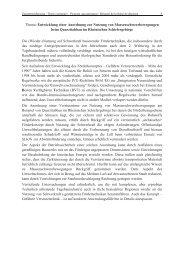Madeira Canary Islands Azores – Fishes Dr. Peter Wirtz
Madeira Canary Islands Azores – Fishes Dr. Peter Wirtz
Madeira Canary Islands Azores – Fishes Dr. Peter Wirtz
Create successful ePaper yourself
Turn your PDF publications into a flip-book with our unique Google optimized e-Paper software.
Mediterranean wrasse (Symphodus mediterraneus)<br />
Up to 20 cm long. <strong>Madeira</strong>, <strong>Canary</strong> <strong>Islands</strong>, <strong>Azores</strong>. 2 <strong>–</strong> 50 m depth.<br />
A dark spot at the base of the tail. A yellow ring around the dark base of the pectoral fins. Territorial males<br />
are red (photo below), females and non-territorial males reddish brown. The Mediterranean wrasse can reach<br />
an age of 8 years. Photo <strong>Peter</strong> <strong>Wirtz</strong>.<br />
108<br />
Rainbow wrasse (Coris julis)<br />
Up to 20 cm long. <strong>Madeira</strong>, <strong>Canary</strong> <strong>Islands</strong>, <strong>Azores</strong>. 1 <strong>–</strong> 150 m depth.<br />
Rainbow wrasses have three sexes! Juveniles (small photo) either grow into females (lower photo) or so-<br />
called “primary males” that look like females but produce sperm. Some of the females later in life change sex<br />
and turn into so-called “secondary males” that are much larger and more colourful (upper photo). Secondary<br />
males are also called supermales. During the reproductive season (the whole summer), they defend territories<br />
of 200 to 800 sqm and do not tolerate other secondary males in them. They continuously swim through the<br />
territory with conspicuous wavelike movements. The brightly coloured beginning of the dorsal fin is fully<br />
displayed like a flag. When a female is ready to spawn it swims a bit upwards into open water. Immediately<br />
the large male joins it closely and both quickly swim up one to three meters. At the highest point, they eject<br />
eggs and sperm, which are visible for a few moments as a milky cloud. The fertilized eggs drift away in the<br />
current. So what about the primary males, the third sex? Primary males can reproduce only in a parasitic way:<br />
they rush towards spawning pairs of supermales and females and eject sperm close to them! Occasionally not<br />
only one but two to four primary males attempt to profit from the spawning of a supermale with a female. As<br />
females never spawn with primary males, primary males are entirely dependent on spawning supermales to









